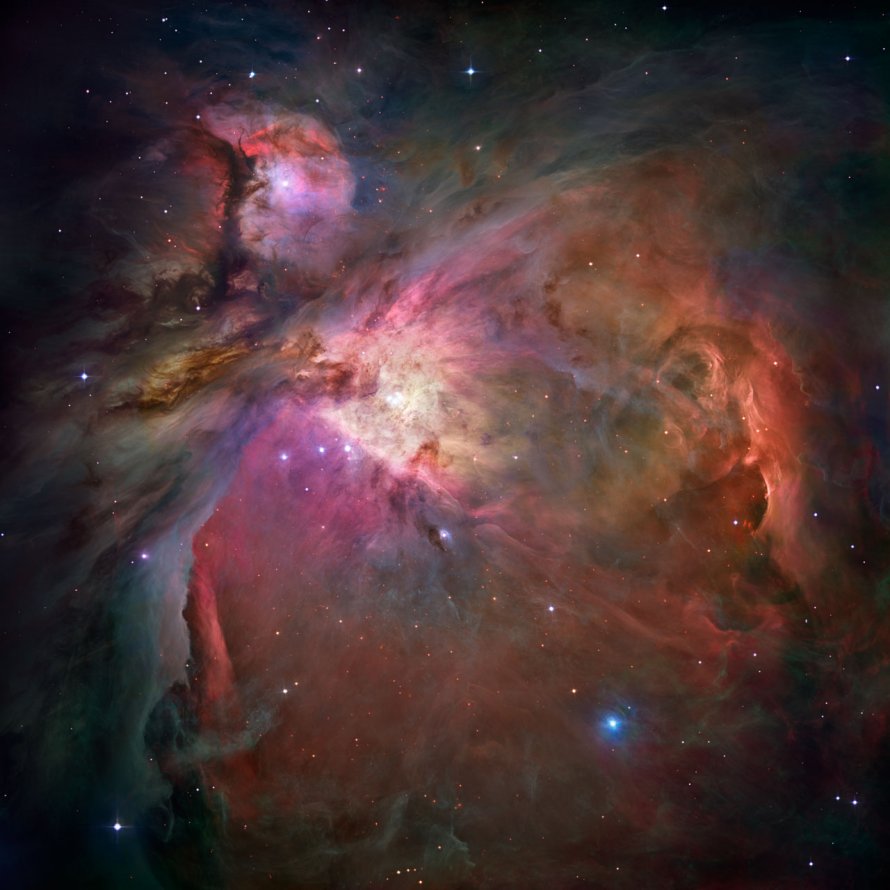M42 (NGC 1976) - Orion Nebula
Messier 42 (NGC 1976), also known as the Orion Nebula, is a diffuse nebula located in the constellation Orion, in the Orion Arm of the Milky Way Galaxy in the Local Group of galaxies. M42 is 1350 light years away from Earth.
M42 is best viewed during winter, is magnitude 4, and can be viewed with naked eye. M42 is 65' x 60' in apparent size. For reference, the full moon is 30'.
Observing difficulty: Easiest
- Name:
- Orion Nebula
- Type:
- diffuse nebula
- Constellation:
- Orion
- NGC or IC:
- NGC 1976
- Magnitude:
- 4
- Viewing:
- naked eye
- Size:
- 65' x 60'
- Distance (light years):
- 1350 LY
- RA:
- 5h 35.3m
- Dec:
- -5 23'
- Season:
- winter
- Milky Way location:
- Orion Arm
- Galaxy group:
- Local Group
- Messier Marathon #:
- 13
- Contains:
- Trapezium Cluster
* The naked eye can see up to magnitude ~7-8 objects under ideal dark sky conditions.
A Closer Look at the Orion Nebula
Messier 42 (M42), commonly known as the Orion Nebula, is one of the most well-known and studied nebulae in our galaxy. As one of the brightest nebulae, it is visible to the naked eye and is an exceptional sight in a telescope or binoculars. This article delves into the detailed scientific aspects of M42, its historical context, physical properties, and tips for viewing this celestial wonder.
Historical Overview
The Orion Nebula was known to many ancient civilizations and was first noted in a scientific context by Nicolas-Claude Fabri de Peiresc, a French lawyer and astronomer, in 1610. Charles Messier cataloged it as the 42nd object in his catalogue in 1769. Given its prominence in the night sky, M42 has fascinated astronomers for centuries and continues to be a focus of astronomical study.
Physical Properties and Magnitude
The Orion Nebula is an emission nebula, meaning it emits its own light rather than merely reflecting the light of nearby stars. The nebula is approximately 24 light-years across and is located some 1,344 light-years away from Earth in the constellation Orion, beneath Orion's Belt.
The nebula's remarkable brightness, with an apparent magnitude of approximately 4.0, is due to a group of hot, young stars known as the Trapezium Cluster at its heart. This cluster, formed around a million years ago, consists of stars that are significantly hotter and more massive than our Sun, resulting in the emission of copious ultraviolet radiation that excites the surrounding gas and causes it to glow.
Astronomical Significance
M42 is a region of active star formation, providing astronomers with a laboratory to study how stars and their planetary systems come into being. In recent years, observations from the Hubble Space Telescope and other observatories have revealed protoplanetary disks, or "proplyds," within the nebula ? these are the embryonic forms of new solar systems, providing precious insight into the birth of stars and planets.
Finding and Observing M42
Located in the Sword of Orion, just south of Orion's Belt, M42 is relatively easy to find in the winter sky in the Northern Hemisphere. To the naked eye, it appears as a fuzzy patch in Orion's Sword. It is one of the few nebulae visible to the naked eye from Earth, especially from darker locations.
With even a small telescope or binoculars, the Orion Nebula transforms into a soft, glowing cloud enveloped by a swarm of stars. Larger telescopes under dark skies can reveal the delicate wisps and structures in the nebula, along with the intense glow of the Trapezium Cluster.



